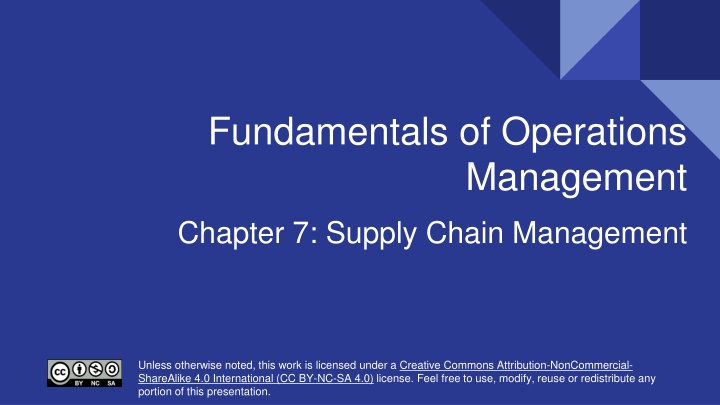
Essentials of Supply Chain Management
Explore the crucial concepts of supply chain management, its role in meeting customer demands efficiently, the key elements of SCM, inventory management practices, transportation modes, technology impact, collaborative practices, and socially responsible SCM principles.
Download Presentation

Please find below an Image/Link to download the presentation.
The content on the website is provided AS IS for your information and personal use only. It may not be sold, licensed, or shared on other websites without obtaining consent from the author. If you encounter any issues during the download, it is possible that the publisher has removed the file from their server.
You are allowed to download the files provided on this website for personal or commercial use, subject to the condition that they are used lawfully. All files are the property of their respective owners.
The content on the website is provided AS IS for your information and personal use only. It may not be sold, licensed, or shared on other websites without obtaining consent from the author.
E N D
Presentation Transcript
Fundamentals of Operations Management Chapter 7: Supply Chain Management Creative Commons Attribution-NonCommercial-ShareAlike 4.0 International (CC BY-NC-SA 4.0) Creative Commons Attribution-NonCommercial-ShareAlike 4.0 International (CC BY-NC-SA 4.0) Unless otherwise noted, this work is licensed under a Creative Commons Attribution-NonCommercial- ShareAlike 4.0 International (CC BY-NC-SA 4.0) license. Feel free to use, modify, reuse or redistribute any portion of this presentation.
7.0 Learning Outcomes In this chapter, we will: Explain the fundamental concepts of supply chain management and its significance in fulfilling customer demands efficiently. Explain the material/goods flow, cash flow, and information flow within a supply chain and discuss their significance in maintaining efficient operations. Identify and explain the four key elements of supply chain management: supply management, internal operations management, distribution management, and integration management. Analyze different supply chain design strategies and assess how companies balance efficiency and responsiveness based on customer needs. Evaluate various inventory management practices and justify the reasons for maintaining different types of inventory within a supply chain.
7.0 Learning Outcomes (cont.) In this chapter, we will: Compare different modes of transportation and discuss how companies choose the most appropriate mode for various types of shipments. Explain the role of technologies such as EDI, barcodes, QR systems, and RFID in enhancing supply chain operations and improving data capture and inventory management. Discuss collaborative practices like Vendor Managed Inventory (VMI) and Collaborative Planning Forecasting and Replenishment (CPFR) and their benefits for optimizing supply chain performance. Identify and explain the elements of socially responsible supply chain management by embracing ethically, socially, and environmentally sustainable practices along with economic gain.
7.1 Introduction Interconnected Network: A supply chain involves organizations working together to fulfill customer orders, from sourcing raw materials to delivering final products. Customer Expectations: Modern customers expect quality goods and services at reasonable prices with excellent pre- and post-purchase service, regardless of the complexities involved in meeting these demands. Value Addition: Each participant in the supply chain, including suppliers, manufacturers, transporters, and retailers, adds value to the process. A failure in any operation can break the chain and disrupt the flow. Weakest Link Principle: The efficiency of a supply chain is determined by its weakest link, highlighting the need for strong supply chain management and collaboration across all participants. Ripple Effect: Inefficiencies in one part of the supply chain, such as a retailer failing to replenish inventory, can have widespread negative impacts, affecting manufacturers and suppliers and leading to financial losses. Collaborative Optimization: Organizations should adopt a collaborative approach, maintaining regular communication and using advanced technologies to proactively address bottlenecks and improve overall supply chain performance, ensuring timely delivery and minimizing waste.
7.1 Supply Chain Network The following image illustrates the supply chain process. It shows resources, including goods, services, and capital, being transformed into customer products and services through the combined efforts of people, technology, and processes. The goal is to deliver quality goods and services efficiently, cost- effectively, and with optimal customer service. Supply Chain Network by Sanaz Habibi, CC BY-NC-SA 4.0
7.2 Managing Main Flows in the Supply Chain Supply chains are governed by three fundamental flows: the flow of materials/goods, the flow of money/cash, and the flow of information. These flows are intrinsically linked and essential for the efficient operation of any supply chain. Information Flow: Bidirectional communication of data such as demand forecasts and inventory levels among supply chain partners for better coordination and decision-making. Material/Goods Flow: Represents the physical movement of products from suppliers to consumers, including reverse logistics for returns. Cash Flow: The flow of money moves opposite to the goods flow, from consumers to suppliers, as payments are made at each stage.
7.2 Synchronization and Optimization Seamless integration of material, cash, and information flows is essential for effective supply chain management. Aligning these flows reduces waste and enhances customer satisfaction. Advanced technologies and collaboration enable real- time monitoring and optimization, boosting efficiency and competitiveness. Figure 7.2.1: Upstream and downstream of a supply chain and its flows. Mods: recoloured by Fanshawe College
7.3 Foundational Elements of Supply Chain Management Effective supply chain management relies on four key elements: supply management, internal operations management, distribution management, and integration management. These elements enable harmonious collaboration among all participants in the supply chain. Figure 7.3.1 illustrates the interplay of these elements within a company s supply chain. Figure 7.3.1: A company s supply chain by Stern, CC BY-SA 3.0. Mods: re-coloured by Fanshawe College. The internal supply chain starts with suppliers providing the raw materials purchased, manufactured into goods and distributed to the customers.
7.3 The Four Key Elements Involves procurement, supplier relationships, selection, contract negotiation, and performance monitoring to ensure reliable material flow. Focuses on production planning, inventory management, HR, and quality control to add value to products or services. Manages customer relationships and ensures timely delivery of the right products or services to meet customer needs and preferences. Uses technologies like ERP systems to facilitate seamless collaboration and information sharing, enhancing overall supply chain coordination. Internal Operations Management Supply Management Distribution Management Integration Management
7.4 Supply Chain Design Supply chain design determines entities' roles, responsibilities, and locations within the supply chain network to align with business objectives and customer preferences. Efficiency vs. Responsiveness: Balancing cost reduction and prompt customer service is key, with companies adjusting their strategies based on customer willingness to wait for orders. Walmart vs. Amazon: Walmart traditionally uses brick-and-mortar stores, while Amazon leverages online platforms and distribution centers for direct shipments. Vertical Integration: Companies own more supply chain stages, like manufacturers owning retail stores (forward integration) or suppliers (backward integration). Horizontal Integration: Businesses expand by merging with or acquiring firms in the same market, like Kraft Foods merging with Heinz or Marriott acquiring Starwood Hotels. Optimizing Design: Careful supply chain design enhances operational efficiency, responsiveness, and competitiveness by evaluating product characteristics, market dynamics, and competitive landscapes.
7.5 The Role of Inventory in the Supply Chain Importance of Inventory Management: Ensures materials and goods are available in the right quantities, at the right locations, and at the right time to meet customer commitments and produce high- quality goods. Types of Inventories: These include finished goods, raw materials, purchased components and operating supplies, and work-in-process. Reasons for Holding Inventories include: Seasonal Demand: Manufacturers increase inventory during specific periods to meet seasonal spikes in demand, such as Christmas season for a chocolate manufacturer. Supply Chain Risks: Companies maintain larger inventories to counter risks like supplier shortages, work stoppages, poor quality, or late deliveries. Cost Optimization: Organizations purchase larger quantities to benefit from discounts, reduce transportation costs, and hedge against future price hikes. Customer Service: Retailers stock inventory to ensure consistent supply and minimize stockouts, balancing costs with meeting customer expectations. Supply Chain Synchronization: Matching material flow with production and customer shipments poses challenges, leading to distributed inventory and increased costs. 1. 2. 3. 4. 5.
7.6 Logistics: Coordinating the Movement of Resources Logistics refers to the coordination and movement of resources, particularly inputs into the transformation process and finished goods out to customers. Logistics Management Decisions: Includes determining in-house vs. outsourced transportation, selecting reliable suppliers, choosing transportation modes/routes, and negotiating shipping rates. Distribution Management Importance: Oversees the movement of goods from suppliers to sale points, crucial for rapid inventory turnover and business profitability. Distribution Functions: Encompasses customer service, shipping, warehousing, inventory control, packaging, receiving, materials handling, and strategic location planning, supported by information systems. Efficiency Goals: Aims for optimal and timely delivery of raw materials and products in perfect condition, combining distribution and transportation as logistics. Cross-Docking Benefits: Streamlines product flow by bypassing storage, reducing inventory costs, accelerating delivery, minimizing handling, and optimizing space utilization for competitive advantage.
7.6 Modes of Transportation Trucking Railroads Airfreight Ideal for small & light products Prioritizes speed over cost Reliable Air pollutant Flexible (truck load vs. less-than- truckload) Drivers in demand Creates highway congestion Ideal for bulkier products or containers Cost effective over distances Energy efficient Waterway Pipeline Multimodal Uses a combination of modes through a carrier Products secured in containers Contractual with a single carrier Used for crude oil, gas, petroleum Once built, very cost effective Land and water pollutant Ideal for low cost, heavy products Very common Inexpensive
7.7 Communication and Technology in the Supply Chain Electronic Data Interchange (EDI): EDI automates exchanging business documents like purchase orders and invoices between partners, enhancing speed, accuracy, cost savings, collaboration, compliance, and traceability. Barcodes: Barcodes facilitate machine-readable data capture for accurate pricing, real-time inventory tracking, error elimination, process streamlining, and product traceability, improving operational efficiency. Quick Response (QR) Systems: QR systems use barcodes and EDI for real-time sales data to enable just-in-time retail replenishment, reducing stockouts, optimizing inventory levels, and enhancing supply chain responsiveness. Radio Frequency Identification (RFID): RFID uses radio waves for wireless data tracking, offering advantages over barcodes like no line-of-sight requirement and applications in inventory management, shipping, asset tracking, and access control. Supply Chain Integration: EDI, barcodes, QR systems, and RFID collectively enhance supply chain performance by improving data accuracy, operational efficiency, and inventory management. Digital Transformation: Adopting technologies like EDI, barcodes, QR systems, and RFID is crucial for businesses to streamline processes, enhance collaboration, and gain competitive advantages.
7.8 Supply Chain Collaboration Vendor Managed Inventory (VMI): VMI involves vendors managing inventory levels at the customer's location using real-time data, benefiting vendors with better stock management and customers with reduced workload and automated replenishment. Collaborative Planning, Forecasting, and Replenishment (CPFR): CPFR enables manufacturers and retailers to share data and collaboratively forecast and plan orders, optimizing inventory, reducing stockouts, and improving demand visibility. Inventory Turnover as a KPI: Inventory turnover, calculated as Cost of Goods Sold divided by Average Aggregate Inventory Value, measures supply chain efficiency, with higher turnover indicating better inventory management. Industry-Specific Inventory Turnover: Different industries have varying inventory turnover benchmarks; higher turnover rates typically indicate efficient inventory management, while lower rates suggest potential inefficiencies. Days of Supply Measurement: Days of Supply, calculated as Average Aggregate Inventory Value divided by Annual Cost of Goods Sold multiplied by 365 days, reflects the amount of inventory on hand, with lower values indicating more efficient inventory management. Additional Performance Measures: Other supply chain KPIs include fill rate, which measures the percentage of customer orders filled from stock, and the percentage of orders delivered on time, indicating customer service efficiency.
7.8 Ethical and Sustainable Practices Socially responsible supply chain management encompasses a range of practices promoting ethical, environmentally conscious, and socially responsible operations throughout the supply chain. The main areas of focus include: Benefits of Socially Responsible SCM: Mitigates risks associated with unethical practices, enhances brand reputation, fosters customer loyalty, and attracts socially conscious investors. Implementation Strategy: Requires strong leadership, clear goals, monitoring and reporting mechanisms, and continuous improvement in line with social and environmental standards. 1. Organizational Practices: Ensure transparency, accountability, and good governance. Ethical Practices: Follow ethical standards and responsible sourcing. Environmental Practices: Reduce carbon footprint and use renewable resources. Human Rights: Respect human rights and ensure fair working conditions. Health and Safety: Implement robust health and safety measures. Community Engagement: Support local communities and promote employment. 2. 3. 4. 5. 6.
Summary & Review Collaborative Nature: Supply chain management involves a network of organizations working together, where each participant adds value, and the overall strength is determined by the weakest link. Importance of Efficiency: Inefficiencies at any stage can impact the entire supply chain s financial performance, necessitating regular communication and coordination to address potential bottlenecks proactively. Three Main Flows: Supply chains are governed by the flows of materials/goods (moving from suppliers to consumers), cash (moving from retailers to suppliers), and information (bidirectional for coordination and communication). Key Elements: Effective supply chain management requires supply management, internal operations management, distribution management, and integration management to optimize operations and achieve goals. Supply Chain Design: Balancing efficiency and responsiveness based on customer preferences, using strategies like vertical and horizontal integration, and focusing on inventory management and logistics. Technology and Communication: Technologies like EDI, barcodes, QR systems, RFID, and collaborative practices like VMI and CPFR streamline operations, enhance data capture, enable just-in- time inventory management, and align supply chain partners for optimal performance.





















